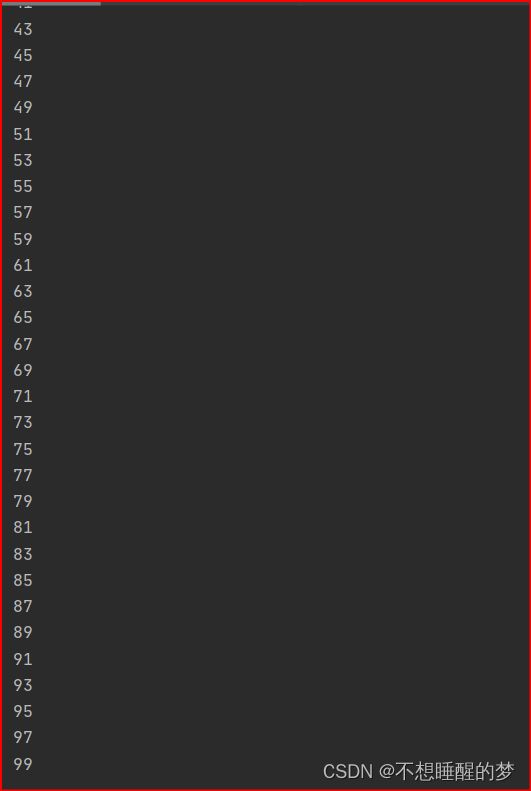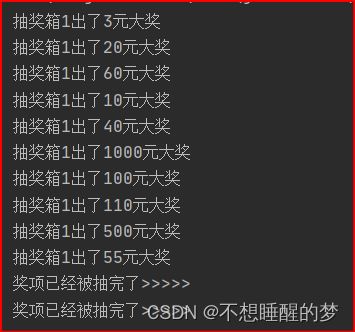Java——关于实现多线程的测试小题,帮助我们更好的理解多线程的使用方法
前面讲解了关于多线程的使用方法,这篇文章则是进行实战,做几道测试题。
感兴趣的情况下可以看一下Java多线程
多线程练习1 (卖电影票)
一共有1000张电影票,可以在两个窗口领取,假设每次领取的时间为3000毫秒要求:请用多线程模拟卖票过程并打印剩余电影票的数量
线程代码:
package Exercise.Exam1;
public class Mythread extends Thread{
static int count = 1;
@Override
public void run() {
while (true){
synchronized (Mythread.class){
if (count<=1000){
try {
Thread.sleep(3000);
} catch (InterruptedException e) {
e.printStackTrace();
}
System.out.println(getName()+"正在卖第"+count+"张票");
count++;
}else
break;
}
}
}
}
测试类:
package Exercise.Exam1;
public class Test {
public static void main(String[] args) {
Mythread mythread1 = new Mythread();
Mythread mythread2 = new Mythread();
mythread1.setName("窗口一");
mythread2.setName("窗口二");
mythread1.start();
mythread2.start();
}
}
运行结果:
多线程练习2 (送礼品)
有100份礼品,两人同时发送,当剩下的礼品小于10份的时候则不再送出。
利用多线程模拟该过程并将线程的名字和礼物的剩余数量打印出来.
线程代码:
package Exercise.Exam2;
public class MyThread extends Thread{
public MyThread(String name) {
super(name);
}
static int count =1;
@Override
public void run() {
while (true) {
synchronized (MyThread.class){
if(count==91){
break;
}
else {
System.out.println(getName()+"送出的第"+count+"份礼物");
int sum = 100-count;
System.out.println("礼物还剩下" +sum +"份礼物");
count++;
if (sum==10){
System.out.println("最后的十份礼物");
}
}
}
}
}
}
测试类:
package Exercise.Exam2;
public class Test {
public static void main(String[] args) {
MyThread thread = new MyThread("马");
MyThread thread1 = new MyThread("安");
thread.start();
thread1.start();
}
}
运行结果:
多线程练习3 (打印奇数数字)
同时开启两个线程,共同获取1-100之间的所有数字要求:将输出所有的奇数。
线程代码
package Exercise.Exam3;
public class Mythread extends Thread{
private static Object object = new Object();
static int num =1;
@Override
public void run() {
while (true){
synchronized (object){
object.notifyAll();
if (num<=100){
int ji = num%2;
if (ji!=0){
System.out.println(num);
}
num++;
}else
break;
}
}
}
}
测试类
package Exercise.Exam3;
public class Test {
public static void main(String[] args) {
Mythread mythread = new Mythread();
Mythread mythread2 = new Mythread();
mythread.start();
mythread2.start();
}
}
运行结果
多线程练习4(抢红包)
抢红包也用到了多线程。
假设:100块,分成了3个包,现在有5个人去抢
其中,红包是共享数据。
5个人是5条线程。
打印结果如下:
XXX抢到了XXX元
XXX抢到了XXX元
XXX抢到了XXX元
XXX没抢到
XXX没抢到
线程代码:
package Exercise.Exam4;
import java.math.BigDecimal;
import java.math.RoundingMode;
public class Mythread implements Runnable {
static double sum = 100.00;
static double num = 0.00;
static int count = 1;
@Override
public void run() {
while (true){
synchronized (Mythread.class){
if(count<3) {
double random = Math.random() * sum;
BigDecimal a = new BigDecimal(random);
BigDecimal bigDecimal = a.setScale(2, RoundingMode.FLOOR);
double money = bigDecimal.doubleValue();
System.out.println(Thread.currentThread().getName() + "获得了" + money + "元");
num = num+money;
sum = 100.00-num;
}
else if(count==3){
double m = 100.00;
double three = m-num;
BigDecimal a = new BigDecimal(three);
BigDecimal bigDecimal = a.setScale(2, RoundingMode.FLOOR);
System.out.println(Thread.currentThread().getName()+"获得了" + bigDecimal + "元");
}
else if (count>=4&&count<=5) {
System.out.println(Thread.currentThread().getName()+"抱歉,您没有抢到红包");
}
else {
break;
}
count++;
Thread.currentThread().interrupt();
break;
}
}
}
}
测试类:
package Exercise.Exam4;
public class Testr {
public static void main(String[] args) {
Mythread mythread = new Mythread();
Thread thread1 = new Thread(mythread);
Thread thread2 = new Thread(mythread);
Thread thread3 = new Thread(mythread);
Thread thread4 = new Thread(mythread);
Thread thread5 = new Thread(mythread);
thread1.setName("马");
thread2.setName("安");
thread3.setName("安");
thread4.setName("好");
thread5.setName("帅");
thread1.start();
thread2.start();
thread3.start();
thread4.start();
thread5.start();
}
}
运行结果:
多线程练习5 (抽奖箱抽奖)
有一个抽奖池,该抽奖池中存放了奖励的金额,该抽奖池中的奖项为(10,5,20350,100,200,500,800,2,80,300,700;创建两个抽奖箱(线程)设置线程名称分别为“抽奖箱1”“抽奖箱2"随机从抽奖池中获取奖项元素并打印在控制台上,格式如下:
每次抽出一个奖项就打印一个(随机)抽奖箱1 又产生了一个10 元大奖
抽奖箱1又产生了一个100 元大奖
抽奖箱1 又产生了一个200 元大奖
抽奖箱1又产生了一个800 元大奖抽奖箱2又产生了一个 700 元大奖
线程代码:
package Exercise.Exam5;
import java.util.ArrayList;
import java.util.Collections;
public class Mythread implements Runnable {
ArrayList list;
public Mythread(ArrayList list) {
this.list = list;
}
@Override
public void run() {
while (true){
synchronized (Mythread.class){
if (list.size() ==0){
System.out.println("奖项已经被抽完了>>>>>");
break;
}
else{
Collections.shuffle(list);
int prize = list.remove(0);
System.out.println(Thread.currentThread().getName()+"出了"+prize+"元大奖");
}
}
}
}
}
测试类:
package Exercise.Exam5; import java.util.ArrayList; import java.util.Collections; public class Test { public static void main(String[] args) { ArrayListlist = new ArrayList<>(); Collections.addAll(list,10,20,3,100,40,55,110,60,500,1000); Mythread mythread = new Mythread(list); Thread thread =new Thread(mythread); Thread thread2 =new Thread(mythread); thread.setName("抽奖箱1"); thread2.setName("抽奖箱2"); thread.start(); thread2.start(); } }
运行结果:
多线程练习6 (多线程统计并求最大值)
在上一题基础上继续完成如下需求
每次抽的过程中,不打印,抽完时一次性打印(随机)在此次抽奖过程中,抽奖箱1总共产生了6个奖项
分别为: 10,20,100,500,2,300最高奖项为300元,总计额为932元在此次抽奖过程中,抽奖箱2总共产生了6个奖项。
分别为:5,50,200,800,80,700最高奖项为800元,总计额为1835元
线程代码:
package Exercise.Exam6;
import java.util.ArrayList;
import java.util.Collections;
public class Mythread implements Runnable {
ArrayList list;
public Mythread(ArrayList list) {
this.list = list;
}
@Override
public void run() {
ArrayList list1 = new ArrayList<>();
int sum1=0;
int Max = 0;
while (true){
synchronized (Mythread.class){
if (list.size() ==0){
System.out.println(Thread.currentThread().getName()+list1+"共有"+list1.size()+"项"+"共"+sum1+"最大值为:"+Max);
break;
}
else{
Collections.shuffle(list);
int prize = list.remove(0);
if(prize>Max){
Max=prize;
}
list1.add(prize);
sum1 =sum1+prize;
}
}
try {
Thread.sleep(10);
} catch (InterruptedException e) {
e.printStackTrace();
}
}
}
}
测试类:
package Exercise.Exam6;
import java.util.ArrayList;
import java.util.Collections;
public class Test {
public static void main(String[] args) {
ArrayList list = new ArrayList<>();
Collections.addAll(list,10,20,3,100,40,55,110,60,500,1000);
Mythread mythread = new Mythread(list);
Thread thread =new Thread(mythread);
Thread thread2 =new Thread(mythread);
thread.setName("抽奖箱1");
thread2.setName("抽奖箱2");
thread.start();
thread2.start();
}
}
运行结果:
多线程练习7(多线程之间的比较)
在上一题基础上继续完成如下需求:
在此次抽奖过程中,抽奖箱1总共产生了6个奖项,分别为:10,20,100,500,2,300
最高奖项为300元,总计额为932元在此次抽奖过程中,抽奖箱2总共产生了6个奖项,分别为:5,50,200,800,80,700最高奖项为800元,总计额为1835元在此次抽奖过程中,抽奖箱2中产生了最大奖项,该奖项金额为800元
以上打印效果只是数据模拟,实际代码运行的效果会有差异
线程代码:
package Exercise.Exam7;
import Exercise.Exam6.Mythread;
import java.util.ArrayList;
import java.util.Collections;
import java.util.concurrent.Callable;
public class MyThread implements Callable {
ArrayList list;
public MyThread(ArrayList list) {
this.list = list;
}
@Override
public Integer call() throws Exception {
ArrayList list1 = new ArrayList<>();
int sum1=0;
int Max = 0;
while (true){
synchronized (Mythread.class){
if (list.size() ==0){
System.out.println(Thread.currentThread().getName()+list1+"共有"+list1.size()+"项"+"共"+sum1+"最大值为:"+Max);
break;
}
else{
Collections.shuffle(list);
int prize = list.remove(0);
if(prize>Max){
Max=prize;
}
list1.add(prize);
sum1 =sum1+prize;
}
}
Thread.sleep(10);
} if (list1.size()==0){
return null;
}
else
return Collections.max(list1);
}
}
测试类:
package Exercise.Exam7;
import java.util.ArrayList;
import java.util.Collections;
import java.util.concurrent.FutureTask;
public class Test {
public static void main(String[] args) throws Exception {
ArrayList list = new ArrayList<>();
Collections.addAll(list,10,20,3,100,40,55,110,60,500,1000);
MyThread mythread = new MyThread(list);
FutureTask futureTask = new FutureTask<>(mythread);
FutureTask futureTask2 = new FutureTask<>(mythread);
Thread thread = new Thread(futureTask);
Thread thread2 = new Thread(futureTask2
);
thread.start();
thread2.start();
Integer integer = futureTask.get();
Integer integer1 = futureTask2.get();
if (integer1>integer){
System.out.println("2最大奖项"+integer1);
}
else
System.out.println("2最大奖项"+integer);
}
}






